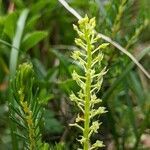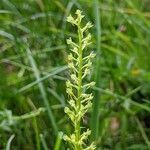Scape 1–2.5 dm; lf solitary, clasping, oval to elliptic, 3–6 cm, usually at least half as wide; infl very slender, tapering to the tip; pedicels 1–2 mm; sep ovate to lance-ovate, 2–2.5 mm, the median erect, the lower deflexed beyond the lip; lateral pet oblanceolate, 1 mm, spreading horizontally; lip greenish-white, deflexed, 2–3 mm, broadly cordate, auriculate-lobed at base, tapering to a long point, minutely erose. Damp woods and bogs; circumboreal, in Amer. s. to N.J., Pa., Ill., Minn., Colo., and Calif. Most of the Amer. plants, including all ours, belong to var. brachypoda (A. Gray) F. J. A. Morris, with the fls merely resupinate, the lip lowermost. (M. brachypoda) Typical Eurasian var. monophyllos has the fls twisted a full circle at base, so that the lip is uppermost. (Microstylis m.)
Plants 3–25(–30) cm. Pseudobulbs 5–10 mm diam. Leaves within proximal 1/3 of stem; blade narrowly to broadly elliptic. Inflorescences spicate racemes, 1–12 cm. Flowers 5–80, resupinate or not; sepals lanceolate to ovate-lanceolate to oblong-lanceolate, margins revolute or not, apex acuminate; petals reflexed, filiform to linear or linear-lanceolate, apex rounded; lip ovate to broadly triangular, concave, base truncate, with forward-directed lobes, apex unlobed, acuminate; column 0.4–0.8 × 0.4–0.8 mm; pollinia yellow. Capsules ascending, ellipsoid, 5 × 3 mm.


